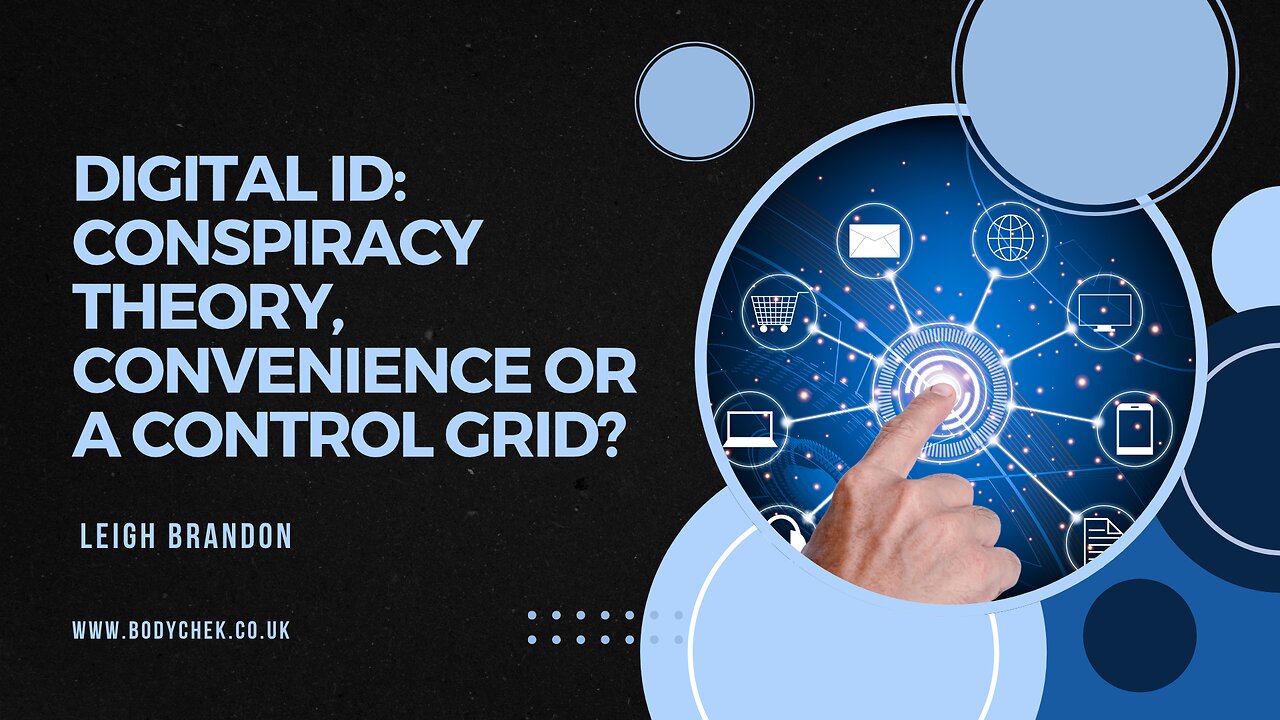Premium Only Content

Digital ID: Conspiracy Theory, Convenience or a Control Grid?
At first glance, talk of Digital ID, CBDCs, and 15-minute cities can sound far-fetched. I used to hope it was far-fetched too. But when I looked directly at official government documents and global policy papers, it became clear these aren’t theories — they are active policies being rolled out, here and abroad. The only real question is: do we understand what they mean for our daily lives and for the freedoms our children will inherit?
In September, the UK government announced plans to introduce a mandatory digital ID system, beginning with “right to work” checks. The first announcement framed it as a measure to stop illegal immigrants coming to the UK on boats and working unlawfully.
But the majority of the public quickly called out this narrative as nonsensical. A digital ID for British citizens would do nothing to prevent illegal immigration by boat — it would only increase surveillance and control over people already here legally. The explanation simply did not add up.
While not yet law, the proposal is expected to pass through Parliament soon.
From Separate Documents to a Master Key
You might be thinking: “We already carry passports, driving licences, and even smartphones that track us — so why worry about a digital ID?”
Here’s the difference: those forms of ID are separate and optional. You use them only when needed. You don’t show your passport at the supermarket, or your driving licence at the doctor’s office. You can choose which to use, when to use it, and in most areas of life, you can still function without them.
A digital ID changes that completely. It acts as a master key — one credential required for employment, banking, healthcare, benefits, travel, and even online access. Unlike your current IDs, you won’t get to pick and choose when to use it. If it becomes mandatory, you will have no choice at all – you will be required to use it if you want to remain in the societal system.
And here’s the real danger: if access is ever restricted, you wouldn’t just lose one document — you could lose access to everything at once. That’s the difference. That’s why this matters.
Facial Recognition: The Silent Enforcer
Alongside digital ID comes facial recognition technology — already deployed in parts of the UK, including high streets, stadiums, airports, and even supermarkets.
Once your digital ID is linked to your face, cameras connected to central databases can identify you in real time, wherever you go. That means:
Walking into a shop could automatically log your presence and purchases.
Attending a protest could be recorded and flagged against your profile.
Entering a train station could automatically deduct payment or deny travel if you’re “non-compliant.”
Your every movement could be monitored without you ever handing over a card or phone.
This isn’t speculation — trials are already happening. London’s Metropolitan Police have used live facial recognition in crowds. Retailers like Tesco have trialled facial recognition for age verification. Airports are increasingly using biometric boarding.
The dangers are clear:
No anonymity in public – every journey, meeting, or event you attend could be tracked.
False positives – facial recognition often misidentifies people, particularly women and ethnic minorities, leading to wrongful arrests or denials of service.
Automated compliance – access to buildings, shops, or services could be silently denied without appeal, simply because the system “knows” who you are and that you haven’t met certain conditions.
Facial recognition makes digital ID not just a pass you show when asked, but a permanent surveillance layer that watches you everywhere, all the time.
Internet of Things and 15-Minute Cities: The Digital Cage Expands
Digital ID and facial recognition don’t operate in isolation — they are part of a wider technological net that includes the Internet of Things (IoT) and so-called 15-minute cities.
Internet of Things (IoT)
The IoT is the network of “smart” devices — from fridges and thermostats to cars, smart meters, and wearable trackers — all connected to the internet and constantly sharing data.
When linked with Digital ID:
Total monitoring – Every action (driving, shopping, heating your home, exercising) can be logged against your personal profile.
Programmable restrictions – Smart meters could ration your energy if your carbon quota is exceeded. Smart cars could prevent you from driving outside your “approved zone.” Smart fridges could report or even restrict your food consumption.
Automatic enforcement – No policeman needed. Your “smart” devices simply block or ration your behaviour based on preset rules.
The IoT provides the infrastructure for invisible compliance enforcement. The rules are no longer enforced by people, but by the very environment you live in.
15-Minute Cities
On the surface, 15-minute cities sound positive: localised communities where everything you need is within a short walk or cycle. But combined with Digital ID, CBDCs, IoT, and surveillance tech, the story changes:
Geo-fencing and mobility control – Travel could be monitored and restricted to your “zone.” Exceeding your trips might trigger fines deducted automatically from your CBDC account.
Facial recognition checkpoints – Smart cameras at roads or transport hubs could deny access if you’ve “used up” your permitted journeys.
Conditional movement – Accessing services outside your zone could require pre-approval via your Digital ID, justified under “climate targets” or “traffic reduction.”
In practice, 15-minute cities risk becoming open-air prisons without walls, where freedom of movement exists only within authorised boundaries.
What Non-Compliance Could Mean in Practice
This isn’t just about abstract freedoms. The knock-on effects of non-compliance would be very real and very human. Imagine:
You try to pay for groceries, but your ID-linked wallet is frozen due to a “compliance issue.” You can’t buy food for your children.
Your rental payment bounces because your access to your own bank account is blocked. You risk eviction.
You’re told your “carbon allowance” is exceeded, so you can’t book a flight to visit family abroad.
You can only purchase red meat once or twice per year, because programmable money restricts you to “approved sustainable diets.”
Your healthcare treatment is delayed unless you meet certain requirements logged on your digital ID (vaccination status, lifestyle behaviour).
Banks and supermarkets are already piloting systems that calculate your personal “carbon footprint” based on what you buy — from food to travel — promoted as part of the so-called human-made climate crisis response. These schemes are usually launched as “optional tools to help you make greener choices.” But history shows they rarely stay optional for long. Once tied to digital ID and programmable money, your ability to purchase what you want could be automatically capped in the name of “sustainability.”
The outcome is devastating. Parents unable to feed their children. Families unable to support one another. Individuals unable to keep a roof over their heads.
How will people feel? Powerless. Fearful. Dependent. When access to essentials can be withdrawn at the click of a button, freedom becomes an illusion.
A Global Agenda, Not Just British Policy
This is not a UK invention. It is part of a global push coordinated through powerful unelected organisations:
The UN – driving digital ID through its “legal identity for all by 2030” Sustainable Development Goal.
The WEF – calling digital ID the “linchpin” of the Fourth Industrial Revolution, linking identity with access to services, payments, and mobility.
The BIS (Bank for International Settlements) – ensuring all CBDCs (central bank digital currencies) require ID verification.
The IMF & World Bank – promoting digital ID and CBDCs as tools for “financial inclusion,” especially in developing nations.
The OECD (Organisation for Economic Co-operation and Development) – shaping global standards for digital governance and ensuring national ID systems are interoperable across borders.
The Gates Foundation & GAVI – funding digital ID initiatives in Africa and Asia as part of health and finance projects.
The Tony Blair Institute – lobbying hard in the UK and abroad for digital ID, framing it as essential for immigration control, fraud prevention, and government efficiency.
This isn’t about one government’s decision. It’s about creating a globally standardised control architecture that can be implemented locally but is ultimately overseen by global bodies with no democratic accountability.
The Democratic Deficit
Over 3 million people in the UK signed a petition against Digital ID.
The Prime Minister has said he will press ahead regardless.
None of this was openly debated during the last election campaign. There was no public mandate.
The “stop illegal immigration” story is just the latest in a long line of false framings used to push intrusive powers: terrorism laws, pandemic measures, and now climate regulations have all been sold under one justification, only to be expanded later for broader surveillance and control.
So who are our politicians really working for? If overwhelming public opposition is ignored and global frameworks are prioritised, it raises a serious question: is Westminster serving its voters, or serving international institutions and corporate partners?
The Danger of Mission Creep
You might be saying to yourself: “It’s just for work checks, what’s the big deal? That doesn’t affect me.”
That’s exactly how these systems are always introduced — small, limited, harmless, and usually “optional” at first. But once the infrastructure exists, governments never stop there. Powers grow, and what was voluntary yesterday quietly becomes mandatory tomorrow.
Think about it:
Terror laws were introduced to tackle terrorism, yet are now used for routine policing.
Covid powers were supposed to be temporary, yet many are still on the books.
Carbon footprint trackers are marketed as “voluntary apps,” yet can easily be tied to banking, supermarket loyalty schemes, and eventually your digital ID.
Digital ID is no different. Today it’s framed as a tool for “right to work” or “stopping illegal immigration.” Tomorrow it could become necessary for renting a home, opening a bank account, booking travel, accessing healthcare, or even posting online.
Even if you trust today’s leaders, what about the next government? Or the one after that? Once the system is in place, it’s not bound by the promises of the people who created it. It will be in the hands of whoever comes next — and there will always be a temptation to expand its use.
A Stark Future for Generations to Come
The threat is not only to us, but to our children, grandchildren, and all future generations.
If we allow this system to take root, they will never know what it meant to:
Access their own money freely without conditions.
Travel where they wish without digital permission.
Eat what they choose without state-imposed quotas.
Speak openly without fear of losing access to their livelihoods.
They will inherit a world where every choice is monitored, approved, or denied by a central authority. A world where freedom has been replaced by conditional access. A world where survival depends not on personal responsibility or community, but on compliance with global rules handed down from above.
And once this system is built, it will not be dismantled. It will be passed down and expanded, generation after generation.
“But Our Leaders Wouldn’t Do That…”
You may be thinking: “I trust the democratic process. Politicians wouldn’t risk bringing in something so harmful. They’d be voted out.”
But here’s the uncomfortable truth: politicians around the world — left, right, and centre — are all introducing the same agenda, almost in lockstep. Do you really think that’s a coincidence?
And once a system like digital ID is embedded, voting it away may not even matter anymore. If your access to work, money, travel, or healthcare depends on the ID, what leverage do you have left?
Democracy only works if you can live and participate without conditions. If your basic freedoms are locked behind a digital gate, controlled by the state or even unelected global bodies, then the ballot box becomes little more than theatre.
So the question isn’t “Would today’s politicians do this to us?” The question is: “Why are they all doing it together, ignoring public opposition, and who are they really working for?”
“Nothing to Hide, Nothing to Fear”?
You may also hear the argument: “If you’ve got nothing to hide, you shouldn’t mind digital ID.”
On the surface, it sounds reasonable. But here’s the problem: it’s not about whether you personally have anything to hide — it’s about who gets to decide what counts as right or wrong.
In the UK today, we already see deep inconsistencies:
Ordinary people can be given long prison sentences for social media posts deemed “offensive.”
Meanwhile, violent offenders or even paedophiles are often released with minimal punishment.
So ask yourself: if the same system that lets dangerous criminals walk free also controls your access to money, food, healthcare, or travel, do you really trust it to use that power fairly?
“Nothing to hide” assumes the authorities will always act justly. But what happens when the rules change? What happens when yesterday’s legal opinion becomes today’s “hate speech”? Or when a lifestyle choice is reclassified as “unsustainable”?
The issue isn’t about hiding anything. It’s about protecting the freedom to live without constant oversight — and not having every detail of your life subject to approval by whoever happens to be in power at the time.
The Solution: Mass Non-Compliance
The system only works if people comply. If enough of us refuse to adopt or use digital ID, the infrastructure cannot succeed.
The solution is simple but powerful: say no. Do not enrol. Do not comply. Do not legitimise the system by participating. And start now by refusing to use biometric data on your devices and apps — such as fingerprint or facial recognition logins. These are already part of the growing digital infrastructure. The less we feed it, the less power it has.
It’s also worth noting that two-factor authentication (2FA) — sold as a tool to “keep you safe” online — is another step toward tying all access to centralised ID systems. While it sounds sensible, in practice it conditions people to accept multiple layers of identity verification, paving the way for Digital ID to become the single, mandatory credential.
History shows that when large numbers of people withdraw consent, even the most powerful systems collapse. The choice is ours – compliance or resistance. Convenience or freedom.
A Critical Juncture for Humanity
Digital ID may be framed as convenient and secure, but convenience is the bait. Dependency is the trap.
If combined with CBDCs, UBI, behavioural tracking, and facial recognition, digital ID could become the infrastructure of a digital cage — like already exists in China: a world where every purchase, movement, and decision is monitored, approved, or restricted by powers outside your control.
These technologies are beginning to look less like free-market tools and more like enforced communism mixed with stakeholder capitalism — a system where elites and unelected organisations manage society from the top down, while ordinary people live under constant surveillance and conditional access.
The choice before us is stark:
Do we comply silently, and pass down to our children a life of conditional access and constant surveillance?
Or do we refuse now, in mass, and protect the principle that identity and access to life’s essentials must remain under individual, not institutional, control?
This is not a fringe issue. It is the defining battle of our generation – and the generations to come.
Final Thought
Freedom is rarely taken in one dramatic act. More often, it is surrendered bit by bit, traded for convenience, until one day people realise they no longer hold the keys to their own lives. Digital ID is that key. Once we hand it over, we may never get it back. The solution is simple: refuse to comply.
Perfect — here’s the standalone afterword version you can drop straight after your article, so it lands as a personal, real-world warning:
Afterword: A Personal Example of What’s Already Happening
Ironically, on the very day I was preparing to release this article, I woke up to find my Facebook and Instagram accounts permanently shut down.
As I investigated, it appeared someone had hacked into my accounts and posted inappropriate images. The platform’s AI instantly flagged these as violations of “community standards” and suspended me.
Here’s the disturbing part: there was no way to speak to a human being. The process was entirely handled by algorithms. Every attempt I made to appeal looped me back into the same system. Worse, the only route offered for reactivation was to hand over biometric data — something I refused to do.
The outcome? I permanently lost both platforms — the two biggest channels I use to share my business and my podcast with thousands of people — all because of something I didn’t do, and because the system had no human accountability.
Now imagine this same logic in a world of mandatory digital ID. What if it’s not just your social media you lose? What if it’s your bank account? Your access to healthcare? Your ability to travel, work, or even speak publicly?
And here’s the real danger: what if a hacker posted illegal content through your account — something you had nothing to do with — and instead of suspending you, the system automatically accused and punished you directly? No human review. No chance to prove your innocence. No due process. Instant and irreversible punishment.
If a hacked account and an algorithm can already erase years of work overnight, imagine when the same system holds the keys to every part of your life.
That isn’t a hypothetical risk. That’s the road we are already on. And it’s exactly why we must say no to Digital ID.
-
 1:20:10
1:20:10
FreshandFit
10 hours agoMiami Halloween Street Debate
184K98 -
 2:06:16
2:06:16
TimcastIRL
13 hours agoTrump Calls For NUCLEAR OPTION, END Filibuster Over Food Stamp Crisis | Timcast IRL
212K155 -
 3:58:54
3:58:54
SavageJayGatsby
11 hours ago🎃 Friend Friday – Halloween Edition! 👻🕷️
47K4 -
 16:16
16:16
Robbi On The Record
12 days ago $21.41 earnedThe Dark History of Halloween | What You Should Know
66.7K67 -
 58:18
58:18
Flyover Conservatives
1 day agoThe Truth About Halloween that You DIDN’T Know - Holiday Special - Historian Bill Federer | FOC SPECIAL Show
60.8K9 -
 3:10:46
3:10:46
Ellie_roe
9 hours agoEllie and Errys Halloween Spooktacular || Random Horror Games
30.5K7 -
 50:27
50:27
Sarah Westall
11 hours agoBig Banks Caught Rigging Market, IMF tells World to “Buckle Up” w/ Andy Schectman
52.6K23 -
 13:54
13:54
Degenerate Jay
18 hours ago $3.41 earned5 Best Superhero Movies To Watch On Halloween
28.8K8 -
 59:03
59:03
NAG Podcast
11 hours agoSarah Fields: BOLDTALK W/Angela Belcamino
50K18 -
 1:21:41
1:21:41
Glenn Greenwald
13 hours agoGlenn Takes Your Questions: On the Argentina Bailout, Money in Politics, and More; Plus: Journalist Jasper Nathaniel on Brutality and Settler Attacks in the West Bank | SYSTEM UPDATE #541
99.2K50